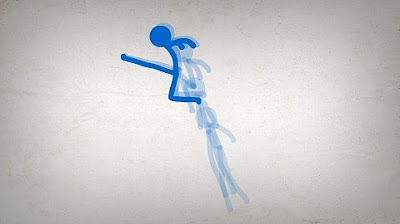The Three Biggest Ideas in Animation
Summary
TLDRIn 'Animation for Anyone', Alex simplifies the art of animation into three core concepts: timing, posing, and spacing. Timing dictates the duration of an action, posing refers to the static image conveying movement and emotion, and spacing is the relationship between frames that creates a sense of motion. By mastering these elements, animators can effectively plan and problem-solve, enhancing their animations with a focus on key poses, timing adjustments, and fine-tuning spacing for a desired motion feel.
Takeaways
- 🎬 Animation can be simplified into three key concepts: timing, posing, and spacing.
- 🕒 Timing refers to the duration of an action or motion within an animation.
- 📸 Posing is about the appearance of an animation when paused, focusing on still images that convey movement, weight, and emotion.
- 🔗 Spacing is the relationship between the still images (poses) over time, essentially the distance between frames which affects the flow of motion.
- 🎭 Historically, posing in animation was about character drawing, but it can now include any visual element shown to the audience.
- ⏱️ Animators control timing by deciding the number of frames a motion takes and the speed at which those frames are displayed.
- 📏 To estimate timing, animators can use film references, stopwatches, or tap along to the action's rhythm to plan their animation.
- 🎭 Posing is crucial as it sets the foundation for the story and motion; without proper poses, timing and spacing adjustments won't compensate.
- 🔑 Key poses are the extreme points of motion that provide the most information about the action, and other poses should logically fit between them.
- 🛠️ When problem-solving in animation, start with posing, then adjust timing, and finally, fine-tune spacing to achieve the desired motion feel.
- 🏋️♂️ Homework: Create simple poses in any medium to communicate concepts such as heavy, soft, hot, bored, and eager.
Q & A
What are the three most important ideas in animation according to the script?
-The three most important ideas in animation are timing, posing, and spacing.
How is timing defined in the context of animation?
-Timing in animation refers to how long something takes to happen, which animators control by deciding the number of frames a motion takes and the speed at which those frames are shown.
What does posing represent in animation?
-Posing is what the animation looks like when paused, representing a still image that can convey movement, weight, and emotion even though it's static.
How is spacing related to the other two ideas of animation?
-Spacing is the relationship between the still images over time, essentially the space between the frames, and it's closely tied to both timing and posing.
What role do poses play in communicating with the audience?
-Poses allow animators to communicate with the audience even before the images start moving, setting the stage for the motion and emotion to be conveyed.
Why is it suggested to start with posing when problem-solving in animation?
-Starting with posing ensures that the essential ingredients for the motion are in place, as it's difficult to adjust the story or motion significantly once timing and spacing are set.
What is the significance of key poses in the animation process?
-Key poses are crucial as they are usually at the extremes of the motion and provide the most information about the character's movement, with all other poses fitting between them.
How does timing affect the perception of a character's motion?
-Timing determines the pace and rhythm of the motion, which can make it feel right or off, and is essential for achieving the desired motion feel.
What practical tools can animators use to help with timing?
-Animators can use film references, stopwatches, or even tapping along to the rhythm of the action to help find a starting point for timing their animations.
How does adjusting spacing impact the feel of the animation?
-Adjusting spacing can create a sense of acceleration, rhythm, flow, and energy, allowing animators to achieve different motion feels such as bouncy, gentle, heavy, or light.
What is the recommended order for planning and problem-solving in animation according to the script?
-The recommended order is to start with posing, then fine-tune timing, and lastly, look at spacing to ensure the motion feels as intended.
Outlines

Dieser Bereich ist nur für Premium-Benutzer verfügbar. Bitte führen Sie ein Upgrade durch, um auf diesen Abschnitt zuzugreifen.
Upgrade durchführenMindmap

Dieser Bereich ist nur für Premium-Benutzer verfügbar. Bitte führen Sie ein Upgrade durch, um auf diesen Abschnitt zuzugreifen.
Upgrade durchführenKeywords

Dieser Bereich ist nur für Premium-Benutzer verfügbar. Bitte führen Sie ein Upgrade durch, um auf diesen Abschnitt zuzugreifen.
Upgrade durchführenHighlights

Dieser Bereich ist nur für Premium-Benutzer verfügbar. Bitte führen Sie ein Upgrade durch, um auf diesen Abschnitt zuzugreifen.
Upgrade durchführenTranscripts

Dieser Bereich ist nur für Premium-Benutzer verfügbar. Bitte führen Sie ein Upgrade durch, um auf diesen Abschnitt zuzugreifen.
Upgrade durchführenWeitere ähnliche Videos ansehen

Blocking Plus Workflow - Part 1 (Timing)

Animation Basics in 14 Minutes (6 Big ideas for beginners)

DASAR ANIMASI untuk Kelas XI Multimedia | Annas Nur Aziz | #vlogngajar #2

Amazingly EASY Way To Rig Characters in Blender 4.1

ALAN BECKER - Stick Figure Animation (revamped)

The History of Animation — Types of Animation Styles Explained [Shot List Ep. 14]
5.0 / 5 (0 votes)
